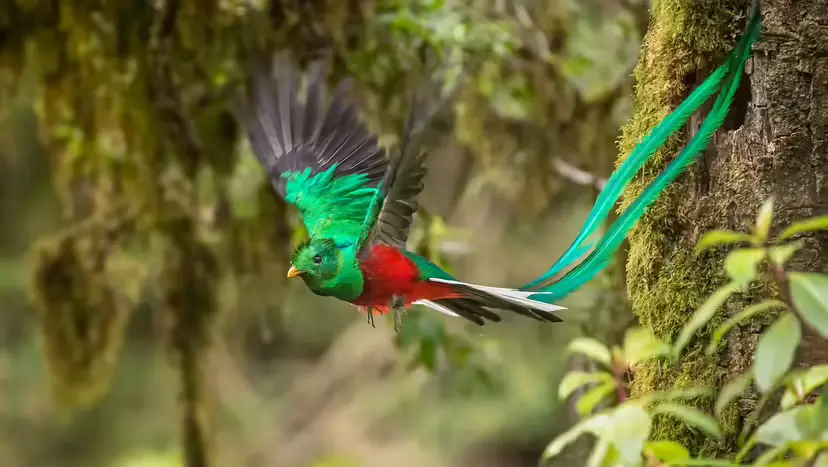Quetzals are jewel-toned trogons from Central & South America; the resplendent quetzal is the most iconic and is woven into Mesoamerican myth alongside the feathered serpent god Quetzalcoatl.
They inhabit humid montane and lowland forests; the resplendent quetzal favors cloud forests.
The biggest threats are forest loss and fragmentation. Males are famous for dramatic tail plumes in breeding season.

“Quetzal” refers to five species in the genus Pharomachrus (family Trogonidae). These medium-sized birds are instantly recognizable: shimmering emerald-green to turquoise backs, contrasting crimson bellies (in several species), and short, rounded wings suited to maneuvering through dense forest. Males grow elongated upper tail coverts (streamers) during courtship, fluttering like banners as they fly.
The name quetzal comes from Nahuatl quetzalli, originally referring to the resplendent quetzal’s brilliant green tail coverts used in regalia.
Resplendent Quetzal – Pharomachrus mocinno
Range: Montane cloud forests of southern Mexico, Guatemala, Honduras, Nicaragua, Costa Rica, W Panama.
Status: Near Threatened (IUCN). National bird of Guatemala; the currency (GTQ) bears its name.
Tail streamers: Up to 35 in / 89 cm in males.
Notes: Partial altitudinal migrant—often moves downslope after breeding as cloud-forest fruit availability shifts.
Golden-headed Quetzal – P. auriceps
Range: Andes from Venezuela to Bolivia (humid premontane to montane forest).
Tail: Up to 6.7 in / 17 cm extended plumes; males show a golden-green sheen on the crown.
Crested Quetzal – P. antisianus
Range: Similar Andean belt (Venezuela to Bolivia).
Tail: Can reach 30 in / 76 cm; subtle head crest; favors mature, mossy forest.
Pavonine Quetzal – P. pavoninus
Range: Amazon Basin (subtropical/low-montane forest).
Notes: Often lower-elevation than Andean congeners; found in terra firme and foothill forests.
White-tipped Quetzal – P. fulgidus
Range: Humid forests of N Colombia & Venezuela.
ID tip: White tips on tail feathers; range-restricted and tied to moist foothill forests.
Eared Quetzal – Euptilotis neoxenus
Family: Trogonidae, but not in Pharomachrus, so not a “true” quetzal.
Range: N Mexico mountains; rare strays into the SW United States.
Alias: Often called the eared trogon.
Habitats: Primary cloud forest, humid montane forest, and—Amazonia for the pavonine—subtropical/lowland rainforest.
Diet: Fruit specialists (notably wild avocados and other laurels); also take insects, small amphibians and reptiles. Their fruit diet makes them key seed dispersers that help sustain forest diversity.
Nesting: Typically tree-cavity nesters, often in soft, decaying trunks or old woodpecker holes; 2 eggs is common.
Display: Males sally out with tails streaming; the surreal plumes are upper tail coverts, not the tail feathers themselves in resplendent quetzals.
In Mayan and Aztec traditions the resplendent quetzal is a symbol of freedom and vitality; feathers were prized for royal garments. The bird likely influenced imagery of Quetzalcoatl, the feathered serpent deity.
IUCN listings:
Resplendent quetzal – Near Threatened (declines tied to deforestation and fragmentation of cloud forest).
Golden-headed, crested, pavonine, white-tipped – Least Concern overall, but many local populations are shrinking where forest is being cleared.
Key threats: Logging, conversion to coffee, pasture, or crops, climate-driven cloud-base shifts (which can dry cloud forests), and loss of large cavity trees.
Protecting intact cloud forest and maintaining elevational corridors so birds can move with fruiting peaks.
Shade-grown coffee/cacao that preserves canopy structure and native trees.
Cavity tree retention and restoration (planting laurel species used for food).
Support for community-based ecotourism, which creates value in keeping forests standing.
Best windows: Local dry seasons & early breeding (often Feb–Jun in much of Central America) when males display.
Hotspots: Costa Rica’s Monteverde & Savegre/San Gerardo de Dota, Guatemala’s Biotopo del Quetzal, Panama’s Volcán Barú slopes; Andean cloud forests for the other species.
Fieldcraft: Stay quiet near fruiting laurel trees; use a guide; keep a respectful distance—no baiting, no playback in sensitive areas.
What do quetzals eat?
Mostly fruits (especially wild avocados), plus insects, and occasionally small amphibians/reptiles.
Why are quetzals important to forests?
They are keystone seed dispersers—their wide-ranging movements spread the large seeds of canopy trees, helping maintain forest structure and diversity.
Which quetzal has the longest plumes?
The resplendent quetzal: male streamers can reach ~35 in / 89 cm in the breeding season.
animal tags: Quetzal
We created this article in conjunction with AI technology, then made sure it was fact-checked and edited by a Animals Top editor.